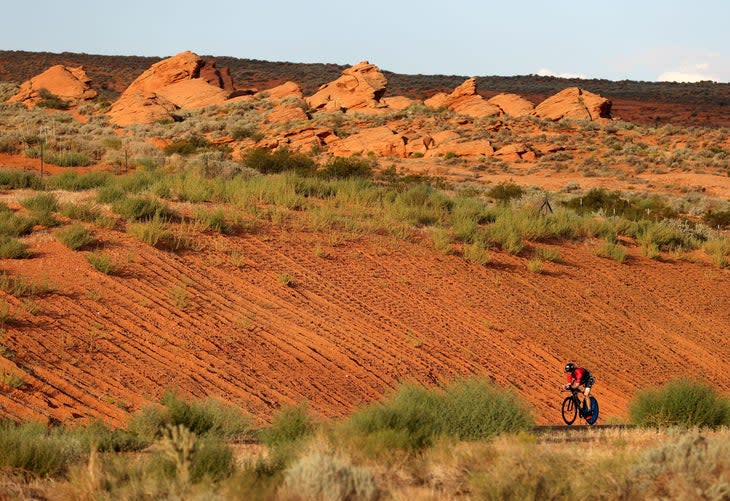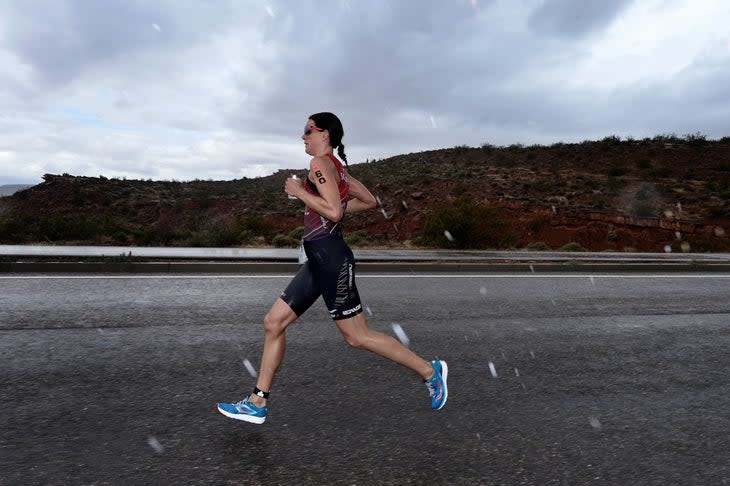To Win Ironman St. George, One Must First Beat the Weather
This article originally appeared on Triathlete
In 16 years of racing as a professional triathlete (and going for her 14th Ironman World Championship appearance), Linsey Corbin has only experienced one hypothermic episode. It happened at the 2016 Ironman 70.3 North American Pro Championship race in St. George, Utah.
"It was brutal," Corbin said. "I sloppily descended off Snow Canyon into St. George, was unable to take my shoes or helmet off in T2, and only made it less than a mile before being pulled off the course as a delirious mess. Do an Ironman! they said. This will be fun! they said. I'd be more than happy to not relive that day again."
When athletes talk about racing in St. George, they always talk about two things: the hills and the weather. Whether racing the full Ironman or the halved 70.3 distance, it's a given that it’s going to be a tough course. But no amount of hill repeats can prepare you for the bigger challenge: covering that terrain in the midst of bone-chilling cold, unrelenting heat, howling winds, or a barrage of rain and hail. Sometimes, all of these can happen in the same ride. Truly, winning Ironman St. George is not about beating the competition; it's about beating the weather.
RELATED: Everything You Need To Know About the Ironman St. George Course

There is no "typical" weather for Ironman St. George. The venue is located in southwestern Utah, at the convergence of three distinct geological areas: the Mojave Desert, Colorado Plateau, and the Great Basin. This location creates a unique red-rock desert landscape, and most days, the weather is what one would think of as a "desert climate.” St. George averages 300 days of sunshine per year, and most of the time, it's fairly warm. But there's also a saying amongst St. George residents: "The weather is always perfect, until it's not."
That weather can change rapidly, without warning, even in the middle of a race. In many other places you can see a storm blowing in--dark clouds gather and winds pick up gradually. That advance warning is not a guarantee in St. George. Wind patterns over the surrounding mountains create a weather phenomenon known as "microbursts," or sudden strong storms with winds up to 50 miles per hour. These microbursts most often happen in the afternoon, but that's not a guarantee. Just ask anyone who raced Ironman St. George in 2012, when a surprise 7 a.m. microburst created 5-foot swells during the age-group swim, or the athletes who had to cope with a sudden torrential storm blowing barricades across the road in the middle of the 2021 Ironman 70.3 World Championship.
Sometimes, the microbursts are accompanied by thunder, lightning, and rain. Other times, it's perfectly sunny out--a lovely day, if it weren't for the tiny bullets of desert sand pelting your skin at 40mph. And perhaps most strangely of all, these storms halt as abruptly as they started, and athletes then must adapt to what comes next--whatever that may be.

Both the full Ironman and the 70.3 in St. George have also had editions as hot as 107 degrees F, with few trees dotting the desert landscape to provide even a sliver of shadow for relief from the burning sun. In other years, the spring race in St. George has happened to coincide with the last gasp of winter. On more than one occasion, athletes have arrived in transition on race morning to discover a delicate layer of frost on their bikes. Sometimes, the race has recorded both of those extremes over the course of the same day, which can change the dynamic of the entire race.
"The weather undoubtedly play a role on race day," said Ben Hoffman, who won the last Ironman St. George race in 2012, and will return to the full course there for the Ironman World Championship on May 7. "It’s impossible to predict what we will encounter. Be prepared for serious variations, and be ready to adapt in the moment and stay positive no matter what. As they say, you can’t control the weather."
RELATED: How the St. George Course Will Create a New Race Dynamic
Corbin says her hypothermic experience, though unpleasant, taught her a valuable lesson about racing: "I think you keep it very simple and ask yourself as you prepare and on race day: Are you doing the best you can? I will be packing my problem-solving cap with me, and I have learned that my best Ironman races come when you don’t expect anything and take it one mile at a time. Everyone will be dealing with some sort of challenge on race day--it’s who can keep a level head and get the most out of the challenging opportunities that will prevail."
And who can deal with whatever the weather throws at them.
Can't get enough Ironman World Championship coverage? Bookmark this page for the latest news and insider info from St. George.
RELATED: How to Watch the Ironman World Championship in St. George
For exclusive access to all of our fitness, gear, adventure, and travel stories, plus discounts on trips, events, and gear, sign up for Outside+ today.

